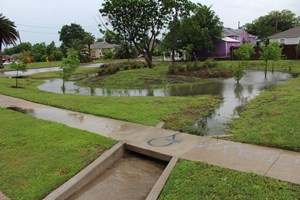Study reveals gaps in resilience planning for US stormwater sector
(UI) — In a recent study conducted by the Water Environment Federation (WEF), critical resilience gaps were found in the U.S. stormwater sector, highlighting challenges in adapting to climate change impacts and addressing aging infrastructure, funding shortages, and workforce needs.
Seeking to take a national-level pulse of the state of the permitted U.S. stormwater sector as well as detail its ongoing challenges, the Water Environment Federation (WEF; Alexandria, Virginia) recently released results from its third National Municipal Separate Storm Sewer System (MS4) Needs Assessment survey.
The survey asked 643 respondents from 47 U.S. states as well as the District of Columbia and Puerto Rico for details on their current resource levels, physical and informational needs to meet regulatory goals, and most significant stressors. For the first time, this survey iteration also queried respondents about their preparedness for the future, featuring questions about climate change resilience planning.
A workgroup of stormwater experts representing the public, private, and nonprofit sectors administered the survey under the coordination of the WEF Stormwater Institute.
“WEF has really filled a data need in the sector,” said Scott Taylor, Chairman of the National Municipal Stormwater Association (Alexandria, Virginia) and a member of the workgroup behind the survey. “This survey fills a real hole about what MS4s struggle with to implement their stormwater program to meet the requirements of the Clean Water Act.”
A shrinking but significant funding gap
The U.S. stormwater sector’s annual funding gap — the difference between current resource levels and those needed to comply with existing federal stormwater regulations targeting quality and quantity — is approximately $6.2 billion for all permitted MS4 organizations.
Although this is a roughly 27% decrease from the funding gap identified in the 2020 MS4 Needs Assessment Survey, the shortfall continues to represent a significant percentage of the U.S. stormwater sector’s overall budget. Survey results estimate that permitted stormwater managers spend between $23.5 billion and $40.5 billion combined each year on stormwater programs and infrastructure. Most respondents reported a need for higher budgets, with only 32% describing their current resource levels as sufficient.
Three major challenges emerged in survey results as the greatest obstacles for the growth and success of the stormwater sector. These include aging infrastructure, lack of funding or availability of capital, and workforce and staffing needs. More than 60% of respondents identified each of these challenges as a top issue. Aging infrastructure and lack of funding have consistently topped the list of reported challenges since the first MS4 Needs Assessment Survey in 2018. The new results show workforce challenges growing in prominence. Survey coordinators attribute this change to an increasingly tight labor market and historically low unemployment rates.
This year’s survey asked respondents for their opinion on the best- and least-developed aspects of their MS4 programs as well as which elements have undergone the most innovation since the program’s establishment. Construction inspection and public engagement commonly ranked as well-developed, whereas green infrastructure guidelines and asset management planning were often poorly developed. Particularly innovative areas included the development and deployment of mapping technologies and alternative project delivery methods.
Adaptation requires information
In a first for WEF’s MS4 Needs Assessment Survey campaign, the 2022 survey asked respondents about the degree to which adapting to the effects of climate change factors into their long-term infrastructure planning efforts.
Results indicated that much of the U.S. stormwater sector is severely unprepared to adapt their practices according to changing precipitation conditions. Less than 10% of respondents had undertaken comprehensive climate change resilience planning, and further, less than 20% of respondents described efforts underway to develop such plans.
Respondents cited unanswered questions surrounding how these changes will manifest locally as well as how to update design standards accordingly as common reasons for the lag in resilience planning. Specifically, responding MS4s expressed need for more detailed information on projected rainfall depths and storm durations as well as how these projections should affect infrastructure sizing guidelines. These needs complement the sector’s requirements for additional funding, as many municipalities currently lack the resources to undertake local-scale studies to inform proper resilience planning.
Survey coordinators describe that these gaps in resilience planning reflect a broader lack of long-term preparation reported among stormwater managers. For example, approximately 45% of respondents did not maintain asset management plans for their stormwater infrastructure, and only about 50% were engaged in some form of watershed-based stormwater planning.
Related News
From Archive

- Glenfarne Alaska LNG targets late-2026 construction start for 807-mile pipeline project
- U.S. water reuse boom to fuel $47 billion in infrastructure spending through 2035
- $2.3 billion approved to construct 236-mile Texas-to-Gulf gas pipeline
- Major water pipe break in Puerto Rico hits over 165,000 customers
- Potomac River Tunnel project enters construction phase beneath Washington, D.C.
- Pennsylvania American Water launches interactive map to identify, replace lead water service lines
- Trump's tariffs drive $33 million cost increase for Cincinnati sewer project
- Utah city launches historic $70 million tunnel project using box jacking under active rail line
- Tulsa residents warned after sewer lines damaged by boring work
- Fatal trench collapse halts sewer construction in Massachusetts; two workers hospitalized




Comments